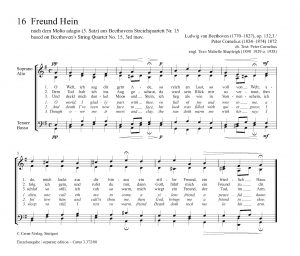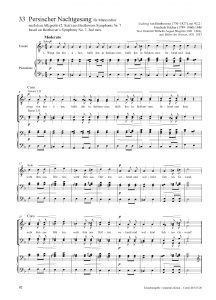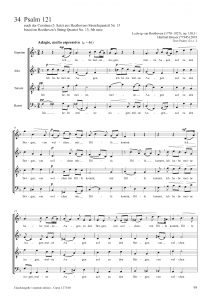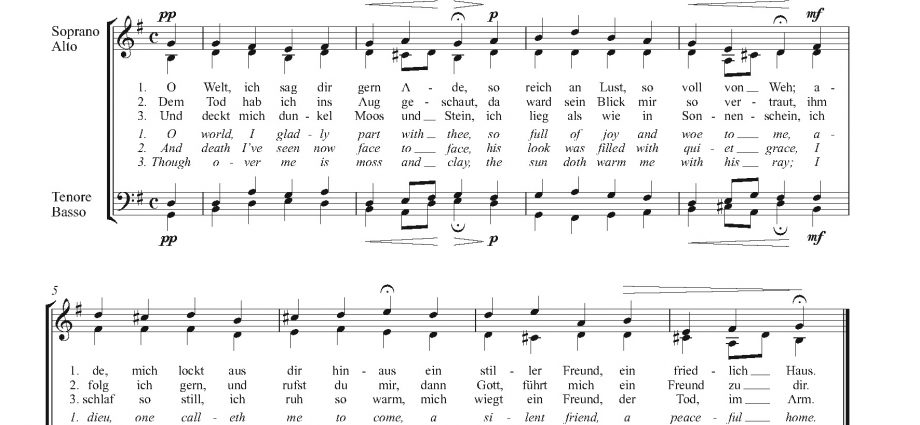Beethoven’s instrumental works with text settings
By Sven Hiemke, musicologist
Beethoven’s instrumental works with text settings: an abomination in the eyes of purists! Although these adaptations cause some ostensible experts to turn up their noses, the process actually has a long tradition. The first choral arrangements of Beethoven’s music were undertaken by close contemporaries. Ignaz von Seyfried, a friend of Beethoven and Kapellmeister and in-house composer at the Theatre an der Wien for example, made an arrangement of Drei Equale for four trombones for male-voice choir, adding texts from the Psalter and by Franz Grillparzer; two of these arrangements were performed among others at Beethoven’s funeral. Seyfried’s colleague Gottlob Benedict Bierey from Wrocław arranged the first movement of Beethoven’s “Moonlight Sonata” as a Kyrie and the second movement of his Piano sonata No. 5 as an Agnus Dei (both for mixed choir).

It seems as though the selection of spiritual and/or liturgical texts was self-evidently ideal in combination with Beethoven’s music, but other lyrical texts were also utilized to blend in harmoniously with the composer’s cantabile slow movements. An example is provided by the Adagio from the Violin sonata No. 7 in the arrangement by Hans Georg Nägeli with the text of Tränentrost. Peter Cornelius also combined the third movement of Beethoven’s String Quartet op. 132, displaying similarities to a chorale which the composer himself had marked with the heading “Heiliger Dankgesang eines Genesenen an die Gottheit” (Holy Song of Thanksgiving to the Divinity by a Convalescent), with his poem Freund Hein.

Is this a sign of arrogance? It is all too easily forgotten in this type of evaluation that terms including “original composition” and “musical authenticity” were not coined until the 20th century. In past eras, the attitude towards arrangements was quite different. Adaptation for a different performance framework, simplification for greater access, clarification and the heightening of expressiveness were only some of the motivations prompting diverse types of arrangements. Even Beethoven himself undertook arrangements of his own compositions and works by other composers. Arrangements were occasionally created for educational purposes: Friedrich Silcher, music director in Tübingen, provided one theme of the Appassionata with a text by Friedrich von Matthisson, a poet much valued by Beethoven, in order to acquaint music lovers who lacked the opportunity of hearing the works in their original version, with his themes. In 1830, he published the Hymne an die Nacht together with eleven additional arrangements under the collective title Melodien aus Beethovens Sonaten und Sinfonien zu Liedern für eine Singstimme eingerichtet (Melodies from Beethoven’s Sonatas and Symphonies in song settings for solo voice). Around thirty years later, Silcher’s arrangement was adapted by Ignaz Heim for four-voice male choir and has now been published in Jan Schumacher’s Choral Collection Beethoven. The Persischer Nachtgesang contained in the same volume had been Silcher’s contribution for the Beethoven Album. Ein Gedenkbuch dankbarer Liebe und Verehrung für den großen Todten (A commemorative volume in grateful love and honour for the great deceased) with the participation of 150 individuals from across Europe. Silcher’s arrangement combines the Gesang der Peri from Bilder des Orients by Heinrich Wilhelm Stieglitz with the slow movement from Beethoven’s Seventh Symphony. The striding rhythm is here transformed into a sort of rocking incantation.

Not all arrangements of Beethoven’s works would be successful a priori, but the adaptation of his solo songs and even instrumental works for choral forces for the most part highlight the cantabile qualities inherent in these compositions. In some of the arrangements, it seems as though the connection between text and music had always existed: as if Beethoven had for example been originally inspired to compose the wonderfully expressive Cavatina in his String Quartet op. 130 by the text of Psalm 121 (“I lift up mine eyes”) which Heribert Breuer only superimposed on this music in the 21st century: as if the composer’s confession revealed by his companion Karl Holz that he had “composed [the music] in tears of melancholy” had been prompted by the emotional content of the psalm text.

These arrangements do in fact reveal aspects of the compositions which have previously been concealed. This also applies to many appropriations which have inspired modern arrangers to create versions for choir, ranging from movements of Beethoven’s piano music, string quartets and even symphonies. These arrangements offer musicians new (old) ways of approaching his music through song, provide unbiased listeners with an original form of entertainment and represent a lively and creative enrichment to the repertoire.
 Prof. Dr. Sven Hiemke is professor of musicology at the Hochschule für Musik in Hamburg. His publications focus on sacred music from the 18th to the 21st century. E-Mail: sven.hiemke@t-online.de
Prof. Dr. Sven Hiemke is professor of musicology at the Hochschule für Musik in Hamburg. His publications focus on sacred music from the 18th to the 21st century. E-Mail: sven.hiemke@t-online.de
Translated from the German by Lindsay Chalmers-Gerbracht

